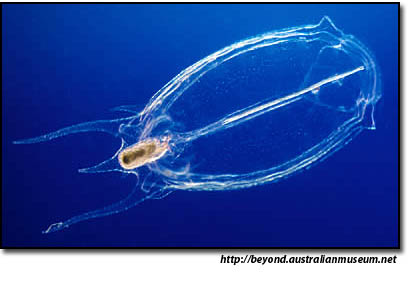“Yuck. There is slimy stuff all over the beach!”
During the last weeks of May, beachgoers and sport fishermen at Ocracoke’s ocean beaches came across an oddity that few recognized.
“A strange kind of slimy grass” was how one fisherman described it. “Gooey strings resembling frog eggs” was someone else’s comment.
The organisms floated in the surf, entangling fishermen’s lines so that they couldn’t fish. Swimmers pulled them out of their hair, remarking on their gelatinous quality with a disgusted “Yuck!” They washed up on the beaches in rafts. Some thought they might be shark or skate eggs or a kind of jellyfish. Others wondered if they were an invasive species about to wreak havoc on Carolina ecosystems, but few knew what they were.
National Park Service ranger Jessica Caldwell had come across them before, in late spring of 2004, when she was working up the beach near Bodie Island. She identified them as salps, or salpa, and she explained that the aquarist at the North Carolina Aquarium on Roanoke Island, Heather Bates, had recognized them when they started showing up on beaches in 2004. She assured everyone that they were harmless.
Salps are fascinating barrel-shaped, free-floating tunicates, which despite their appearance have no relationship to the primitive jellyfish they resemble. They belong to the same phylum as human beings and other vertebrates — Chordata. They have primitive spinal chords or notochords, as well as muscles, primitive nervous systems, and brains. They have, according to William W. Kirby-Smith, a marine ecologist at the Duke University Marine Lab at Beaufort, an eye around their brain which collects light but does not form images, and are “our closest-related relative among invertebrates.”
They are closely related to the Ascidians, known as sea squirts or sea grapes, which are often found clinging to dock pilings and other underwater objects. But whereas sea squirts are sessile, attaching themselves to one spot and staying there the rest of their lives, salps are planktonic animals, never settling down anywhere.
While common in many seas, including the temperate waters of the eastern seaboard of the United States, salps are most prolific in the Southern Ocean, near Antarctica, where their numbers sometimes supersede those of the abundant krill. They are often seen at the surface of offshore waters, either singly or in long string colonies such as the ones observed at Ocracoke. And while they do not come ashore often, onshore waves and currents may wash them in. They are, according to Kenneth Gosner’s “Atlantic Seashore Guide,” infrequent visitors but may sometimes be found in abundance.
May at Ocracoke was obviously one of those times.
The salps that washed ashore in 2004 were identified as Thalia democratica, a species described as transparent with a blue spot at one end. It is probable that the salps at Ocracoke this year are the same species. While each individual organism is less than one inch long, the chains they form can be several meters in length.
Salps feed by pumping water through their bodies and straining out the phytoplankton that form their diet. They have complex and fascinating life cycles, with alternation of sexual and asexual stages, or generations. The two stages look quite different, though they exist together in the sea. The solitary phase, known as an oozoid, is a single barrel-shaped animal which reproduces asexually (without a mate). It produces chains of individual animals known as blastzoids which are hermaphrodites, which means they change sexes and reproduce sexually.
Richard Harbison, a marine biologist from Woods Hole Oceanographic Center, described how, when responding to large phytoplankton (algal) blooms, salps multiply rapidly. Female salps produce an embryo that buds an aggregate, which is female. The “mother” salp then grows testes and becomes male, releasing sperm which fertilizes the aggregate. The entire cycle takes less than two days.
Inconvenient as their presence may be to beachgoers, salps play an important ecological role in the ocean. By feeding on the phytoplankton in algal blooms, they reduce outbreaks which might otherwise wreak havoc on ocean ecosystems . When there is a large bloom, they multiply faster than any other multi-cellular animal and reduce the size of the bloom. Salps also play a role in the ocean food chain by providing dinner (themselves) for fish, sea turtles, and jellyfish.
Some scientists think that the organisms called salps may actually be useful in counteracting predicted rises in global temperatures.
The sinking bodies of salps and their fecal pellets carry carbon to the sea floor, and when in great abundance can alter the ocean’s carbon cycle and change its biological pump.
Research in Australia and other countries support this possibility. LiveScience.com reported on July 20, 2006, that “gummy bears (salps) fight global warming,” and ABC Radio, The World Today’s Nov. 17, 2008 edition said that “jelly blobs (salps) may hold the key to climate change.” They theorize that if enough salps carry carbon to the ocean floor, the heat trapped by carbon in the atmosphere could be reduced.
So, even if salps clog up your fishing line and slide into your hair, give the creatures the credit and admiration they deserve.









